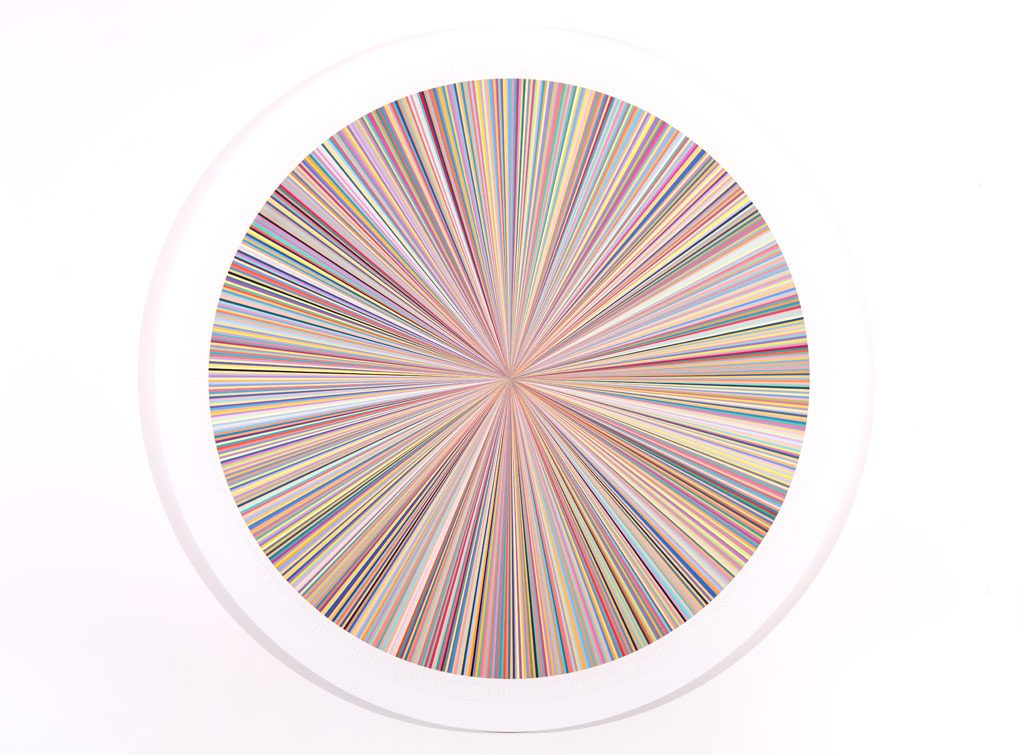
Since 2003 Rachael Clewlow has been meticulously documenting her everyday movements in a series of uniform, A6, black moleskin diaries. Her precise, handwritten ledger in .3 black fineliner down the left-hand edge of each page records her minute-by-minute journeys according to the things, places and people she observes en route e.g. ‘...11.44 Snowdrops 11.45 Man asleep in underpass 11.46 Windsor Terrace 11.47 Robinson Library…‘. The diaries possess a faithful, understated poetry in their sparely penned moments of contrasting beauty and dereliction but these are just the beginning of a process which transfigures Clewlow’s everyday journeys, observations and encounters into a powerful body of scintillating prints and paintings. 3,200 Colours at Vane, Newcastle upon Tyne presents some of the most recent works from her ongoing investigations.
The show opens with two rooms of screen prints from Clewlow’s series of performative walks conducted in Newcastle, Rochdale and London. Through the technical restrictions of the screen printing process and the employment of reduced colour palettes the prints both condense and introduce the methods and sites of Clewlow’s investigations. In ‘Sightlines’, London (2017), for example, the thousands of observations and colour permutations of the London paintings have been reduced to four hundred notations and a palette of eight softer, more translucent hues. ‘Sightlines’, London, unlike most of the other prints and paintings, integrates both ‘Map’ and ‘Key’ elements in one image. However, even equipped with both map and key, ‘Sightlines’, London resists any finite interpretation of a statistical space-time narrative. Instead, through its delicate, abstract and coded colour-data, the work gently insists on the infinite, invisible and unknowable qualities of both the landscape explored and the artist’s lived experiences of it.

Rachael Clewlow, Man Made Water Ways, 91.9 Miles Walked, Rochdale (Map) (detail), 2017, acrylic and silverpoint on board, 90x122cm. Image courtesy of Vane.
The idiosyncratic colour wheel of ‘Sightlines, London’ is mirrored on the corresponding wall of the next room by a pair of circular paintings from the same investigation: ‘London Sightlines (Map)’ (2018), and ‘London Sightlines (Key)’ (2018). The thirteen legally protected vistas of St Paul’s Cathedral underscores ‘London Sightlines (Map)’ which Clewlow has marked out in straight, silverpoint lines running from each of the specific viewpoints and converging at the Cathedral. Meandering around, over and along these lines are beaded paths of tiny, exquisitely painted shapes tracing the actual paths taken by Clewlow whilst recording her minutiae minute-by-minute encounters. Each shape is divided in half, the two halves painted in complementary colours (seemingly of no particular pattern) so that a tiny diamond of indigo and yellow may be followed by a larger circle of red and green or a hexagon of blue and orange. There is something vaguely reminiscent of Harry Beck’s iconic London Tube Map about these spidery chains of coloured infographics which distorts users sense of geography and locatedness by altering it to one of connective relations, fare zones and travel times. In contrast, Clewlow’s ‘London Sightlines (Map)’ is one which has been informed by, and refers to, the lived experience of walking the capital’s streets including all of the banal, sublime and strange sights and experiences that involves.

Rachael Clewlow, Man Made Water Ways, 91.9 Miles Walked, Rochdale (Key) (detail), 2017, acrylic and silverpoint on board, 120cm diameter. Image courtesy of Vane.
In contrast to the white space of ‘London Sightlines (Map)’ its corresponding sister painting ‘London Sightlines (Key)’ is a vortex of thousands of coloured lines, each contracting from the circle’s precisely annotated perimeter to its centre. The ‘Key’ pieces in all of the groups present in the show (Newcastle, Rochdale and London) demonstrate that Clewlow’s investigation is not merely the works’ subject matter. The collisions of colour within the pieces – the resultant harmonies and dissonances, and the way in which all colours change according to what they sit alongside – deliberately plays upon the chameleon, ever shifting and eternally unfixable qualities of colour itself.
Something which is amplified in this new body of work, but which has been present throughout Clewlow’s painterly trajectory, is a sense of freedom and chance born out of order and constraint. The strict, predetermined rules and parameters Clewlow sets herself – whether the routes of her journeys or repeated rhythm of her recordings – generate many unexpected and joyful encounters with the everyday. This is particularly evident in her new group of small works in which the compositional shapes of her Rochdale paintings have broken free from the containment of the painted board and float on the white space of the gallery wall. Each of the eighteen shapes corresponds to one of the recorded moments from the walks Clewlow conducted along the man made waterways of ‘Rochdale; Odd Structure in Reservoir (21.03.17 12.28) 739’ is an equilateral triangle of dusty blue and violet; ‘Fallen Tree in Canal (22.03.17 13.24) 1017’ is a hexagon of orange and blue; whilst ‘Sound of Children Playing (17.06.16 12.23) 261’ is a large lozenge of violet and yellow.
3,200 Colours is a deft and rigorous exploration of memory, language, colour and the infinite relativity and subjectivity of all these. Clewlow’s exquisite anthropology of the commonplace and everyday continues as part of ‘3,200 Colours at Vane until the 19th of May.
3,200 Colours, Vane, Newcastle upon Tyne, 26 April – 19 May 2018.
Iris Priest is a writer, artist and researcher based in Newcastle upon Tyne.
Published 23.05.2018 by Christopher Little in Reviews
891 words